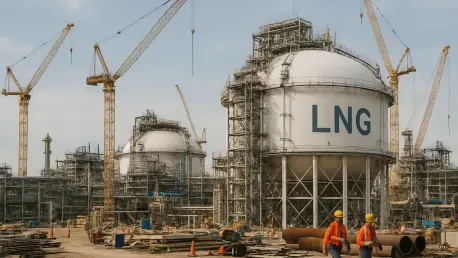In the dynamic landscape of global energy markets, a staggering $6.7 billion investment in a single phase of the Rio Grande LNG Facility in Brownsville, Texas, underscores the seismic shifts underway in the liquefied natural gas (LNG) sector. Spearheaded by NextDecade, this project not only highlights the escalating demand for cleaner energy alternatives but also positions Bechtel, a construction titan based in Reston, Virginia, as a linchpin in shaping the future of U.S. energy infrastructure. This market analysis delves into Bechtel’s pivotal role in this multi-billion-dollar endeavor, examining current trends, financial commitments, and projections for the LNG industry. By unpacking the implications of legal resolutions, policy tailwinds, and production capacities, this exploration aims to provide stakeholders with critical insights into how such large-scale projects are redefining energy supply chains amid a global push for sustainability.
Market Dynamics Driving LNG Investments
Surge in Global LNG Demand and U.S. Positioning
The LNG market is experiencing a robust upswing, fueled by international calls for cleaner energy sources to replace traditional fossil fuels. As nations pivot toward reducing carbon footprints, the United States has emerged as a leading exporter of LNG, capitalizing on abundant natural gas reserves and strategic coastal infrastructure. The Rio Grande LNG Facility stands as a testament to this trend, with its location in South Texas offering proximity to key shipping routes for global distribution. Bechtel’s involvement, backed by decades of expertise in energy projects, aligns with a broader market movement where seasoned contractors are increasingly tasked with executing complex, high-stakes developments to meet soaring demand.
Financial Scale and Investment Trends in Energy Infrastructure
Investment in U.S. LNG infrastructure has reached unprecedented levels, with projects like Rio Grande LNG reflecting a trend of escalating capital commitments. Bechtel’s contracts, totaling over $21 billion across multiple phases of the facility, highlight the financial magnitude of such initiatives. Specifically, the $6.7 billion allocated to Train 4, including a $4.77 billion construction contract awarded to Bechtel earlier this year, illustrates the market’s willingness to channel substantial resources into energy hubs. This pattern of large-scale funding is driven by projections of sustained global appetite for LNG, positioning facilities like this one as critical assets for energy security and economic growth over the next decade.
Policy Environment Accelerating Project Timelines
A supportive policy framework in the U.S. has become a catalyst for rapid advancements in LNG projects. Recent amendments to the National Environmental Policy Act, coupled with technology-driven federal permitting processes under the current administration, have streamlined approvals for major energy developments. This shift has directly benefited initiatives like Rio Grande LNG, enabling quicker resolution of legal challenges and facilitating financial closures. Market analysts observe that such regulatory reforms are reshaping the pace of infrastructure rollout, creating a more favorable environment for contractors like Bechtel to execute projects within compressed timelines while navigating environmental and community considerations.
Bechtel’s Contractual Footprint and Production Projections
Train 4 as a Market Benchmark with $6.7 Billion Investment
At the heart of Bechtel’s current engagement lies the construction of Train 4, a cornerstone of the Rio Grande LNG Facility with a total cost of $6.7 billion. Following significant legal clearance earlier this year, NextDecade achieved financial close and issued a full notice to proceed to Bechtel, marking a pivotal moment for the project. With an anticipated LNG production capacity of 6 million tons per annum (MTPA), Train 4 is poised to contribute significantly to the facility’s overall output. This segment of the market analysis underscores how such investments are setting benchmarks for future LNG developments, reflecting confidence in long-term demand despite risks like regulatory scrutiny or funding fluctuations.
Expanding Scope with Train 5 and Phase 1 Commitments
Bechtel’s role extends well beyond a single train, with a $4.32 billion contract for Train 5, bringing their involvement in these two segments to nearly $9 billion. Additionally, their responsibility for Phase 1, which includes the first three trains valued at $12 billion, elevates their total stake to over $21 billion. This expansive scope mirrors a market trend where contractors are entrusted with multi-phase projects to ensure continuity and efficiency. With a final investment decision for Train 5 expected in the last quarter of this year and completion timelines targeting 2030 for Train 4 and 2031 for Train 5, Bechtel’s phased strategy aligns with market cycles, balancing immediate output needs with long-term capacity growth.
Capacity Projections and Global Supply Implications
The Rio Grande LNG Facility’s cumulative production capacity under construction stands at an impressive 24 MTPA, positioning it as a heavyweight in the global LNG supply chain. This output potential is a critical factor in market forecasts, as it addresses the rising needs of international buyers seeking reliable energy sources. Bechtel’s execution of this capacity underscores their strategic importance in bridging supply gaps, particularly as geopolitical tensions and energy transitions heighten the urgency for stable LNG exports. Market data suggests that facilities of this scale could influence pricing dynamics and trade patterns, reinforcing U.S. dominance in the sector through the coming years.
Future Outlook and Strategic Market Implications
Technological Innovations and Cost Efficiencies
Looking ahead, the LNG market is likely to benefit from innovations such as modular construction techniques and digital project management tools, which could enhance Bechtel’s delivery of complex projects. These advancements promise to reduce costs and accelerate timelines, addressing historical challenges in large-scale energy builds. As the industry evolves, integrating such technologies may become a competitive differentiator, enabling firms to manage risks like labor shortages or material price volatility while maintaining profitability in a capital-intensive sector.
Economic and Regulatory Variables Shaping Growth
Economic factors, including fluctuations in natural gas prices, alongside potential regulatory shifts under future administrations, will play a defining role in the LNG market’s trajectory. While current policies favor rapid development, changes in environmental mandates or trade agreements could introduce uncertainties. Industry projections indicate that Bechtel’s entrenched position, bolstered by multi-billion-dollar contracts, provides a buffer against such variables, ensuring continuity in project execution. Stakeholders must remain vigilant, however, as global demand patterns and policy landscapes evolve in tandem with energy transition goals.
Reflecting on Market Insights and Actionable Strategies
Looking back, the analysis of Bechtel’s involvement in the Rio Grande LNG Facility reveals a market driven by unprecedented investments, supportive policies, and soaring global demand for LNG. Their $21 billion commitment across multiple phases, including the $6.7 billion Train 4, positions them as a cornerstone of U.S. energy infrastructure expansion. For industry players, the takeaway is clear: partnering with experienced contractors offers a proven pathway to navigate financial and regulatory complexities. Moving forward, energy firms should prioritize adopting emerging technologies to enhance project efficiency while closely monitoring policy shifts that could impact timelines. Additionally, aligning investment strategies with projected completion dates, such as 2030 for key phases, will be crucial to capitalize on market demand peaks, ensuring sustained growth in an increasingly competitive LNG landscape.









